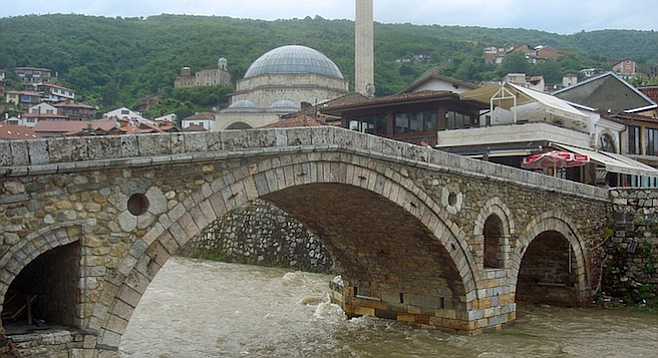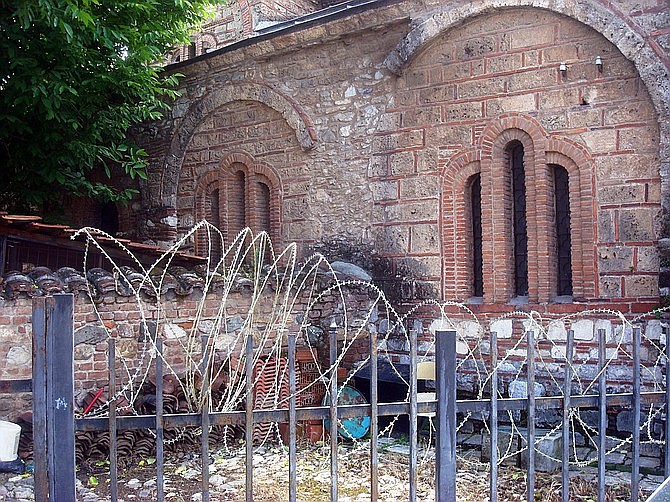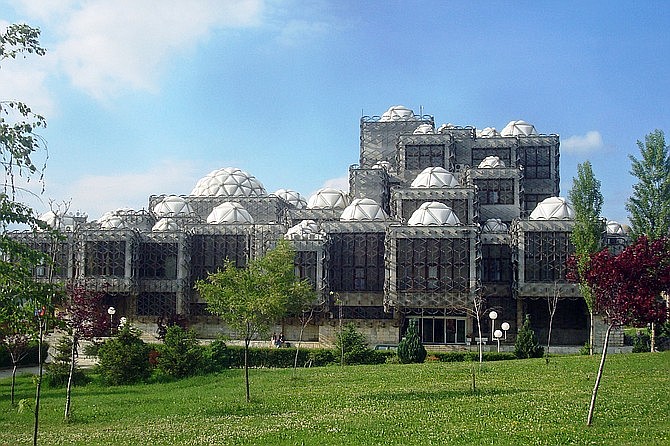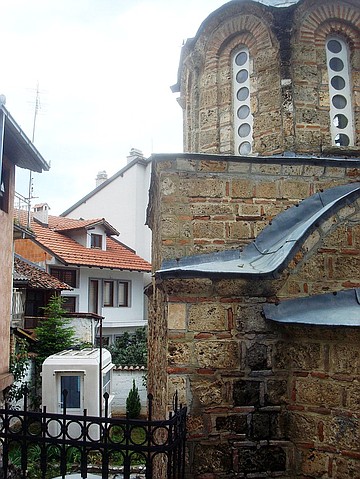 Facebook
Facebook
 X
X
 Instagram
Instagram
 TikTok
TikTok
 Youtube
Youtube

1/18 UPDATE: see this link on travel safety if visiting Kosovo. Travel to the north of the country is currently not advised, other areas are relatively safe.
"What brings you to Kosovo?"
In most countries, it is simply assumed that tourism is the reason. But in this tiny nation of just 2 million people, tucked between Serbia and Albania, the foreign faces have almost all been connected to peacekeeping operations and distribution of billions of aid dollars from Western countries. The fact that there is no tourist information office — nor even the ability to use Google street view — is further confirmation that tourists are a rare sight.
Just a hundred years ago, Pristina was a multicultural and vibrant trading city, with a huge bazaar in its center, an urban elite who spoke Turkish, a Serbian population with strong ties to the Orthodox church, a strong Jewish community which was even in charge of its own schools, as well as the large Albanian population, most of whom were Muslim, but with a small percentage who were Catholic. Today, aside from all the expats, it is nearly all Albanian Muslims.

Despite having a well-developed café society, Pristina is rather hard to fall in love with. Aside from a brief stint with the distinction of being the “World’s Newest Capital City” from 2008 to 2011, there are few Guinness Records it is likely to beat. The city has relatively few sights and some really terrible urban planning which leads to a mishmash of architectural buildings side by side. It is also not an easy place to get around — since street names change as regularly as did the regimes, and there does not seem to be agreement on the current name.
Being “wet behind the ears” as a nation is almost a point of pride. One would not expect to see this freshness illustrated in a nine-ton, ten-foot-high by eighty-foot-long monument, but this is just the kind of quirky thing you find in Kosovo. Basically the monument consists of seven block letters spelling out NEWBORN. It was initially painted yellow, one of the colors in the Kosovo flag, and was unveiled on the day the country declared its independence from Serbia in 2008.
Each year, it is repainted to reflect what is on the minds of the people. For example, in its second year, it was decorated with the flags of the nations that recognize Kosovo as a country. Two years later it was sky blue with cumulus clouds. But a closer examination showed that barbwire surrounded the sky view, signifying the isolation felt on the ground.
When we visited, the letters “N” and the “W” had been toppled and the other letters painted gray with touches of faux brick. For the better part of an hour, I asked everyone in the vicinity why the letters had fallen. No one knew and would not even hazard a guess. Not until I examined my photos at home did I notice that on the ground, there was a kind of crossword puzzle with an “O” painted below the fallen “N” and the letters “a-l-l-s” beside the “W.” Thus, No Walls. And walls are on the Kosovars’ mind after an incident this year in which Serbs built a wall to separate the ethnically divided city of Mitrovica.

While there may be only a few sights in Pristina, what they have is unique. The most notable building is the National Library on the campus of the university. The building was intended to include both Ottoman and Albanian elements, but there is little consensus on which aspect is which. The prevailing view is that the domes are an Ottoman influence — and the roofline does look like the Topkapi palace. But there is another camp that claims that the domes represent the Kosovar Albanian population’s brimless felt hats (plisi).
The symbolism of the metal work woven around the concrete exterior denotes is also up for grabs. Perhaps a harem screen for the Turkish part of the fusion? But others seem to think differently. Apparently, the official cutting the ribbon thought it was just a mistake and chastised the builders for failing to remove the scaffolding before the ceremony. And then we overheard one student saying he thought that it was to remind you to “Study hard and finish school, lest you be imprisoned here.”
If Prishtina is the modern face of Kosovo, Prizren is a glimpse into its past with a history of the city dating at least to the 2nd century AD.
This museum city did not undergo heavy-handed demolition by Yugoslav Communists, as Pristina did; instead, ample evidence of its Ottoman past is extant. With upper stories of houses jutting forth into the street and delicious Turkish food predominating, it is the only place in Kosovo where Turkish remains an official language. This becomes particularly handy for the hoards of Turkish visitors who descend on the town to purchase their very expensive, gold-embroidered wedding outfits.

The preserved city center delights with multiple fountains, bridges spanning the fast-flowing Bistrica River, ancient churches, and mosques from the 16th century. There is even a medieval fortress on the hilltop, protecting the city below. But it has hardly had an easy ride in history, and the number of different “occupiers” are legion — including Romans, Bulgarians, Byzantines, Serbians and Ottomans.
There is still a lot of ethnic tension in the area. Many of the ancient Serb Orthodox churches were badly damaged during the riots, including a UNESCO World Heritage Site built in 1307. Clearly, the city is afraid to re-open the churches since they fear that anger lying right below the surface would simmer over and cause a new set of conflicts. Therefore, many churches remain in ruins and are closed to visitors, with only the rare clergy being permitted entry. Air-conditioned guard cubicles stand at the church gates to keep an eye on things.
And what is the logical end of a trip to a visit to Kosovo? A departure from the world’s emptiest airport (shall we call it “pristine?”) which awaits larger inflows from a more welcoming world.


1/18 UPDATE: see this link on travel safety if visiting Kosovo. Travel to the north of the country is currently not advised, other areas are relatively safe.
"What brings you to Kosovo?"
In most countries, it is simply assumed that tourism is the reason. But in this tiny nation of just 2 million people, tucked between Serbia and Albania, the foreign faces have almost all been connected to peacekeeping operations and distribution of billions of aid dollars from Western countries. The fact that there is no tourist information office — nor even the ability to use Google street view — is further confirmation that tourists are a rare sight.
Just a hundred years ago, Pristina was a multicultural and vibrant trading city, with a huge bazaar in its center, an urban elite who spoke Turkish, a Serbian population with strong ties to the Orthodox church, a strong Jewish community which was even in charge of its own schools, as well as the large Albanian population, most of whom were Muslim, but with a small percentage who were Catholic. Today, aside from all the expats, it is nearly all Albanian Muslims.

Despite having a well-developed café society, Pristina is rather hard to fall in love with. Aside from a brief stint with the distinction of being the “World’s Newest Capital City” from 2008 to 2011, there are few Guinness Records it is likely to beat. The city has relatively few sights and some really terrible urban planning which leads to a mishmash of architectural buildings side by side. It is also not an easy place to get around — since street names change as regularly as did the regimes, and there does not seem to be agreement on the current name.
Being “wet behind the ears” as a nation is almost a point of pride. One would not expect to see this freshness illustrated in a nine-ton, ten-foot-high by eighty-foot-long monument, but this is just the kind of quirky thing you find in Kosovo. Basically the monument consists of seven block letters spelling out NEWBORN. It was initially painted yellow, one of the colors in the Kosovo flag, and was unveiled on the day the country declared its independence from Serbia in 2008.
Each year, it is repainted to reflect what is on the minds of the people. For example, in its second year, it was decorated with the flags of the nations that recognize Kosovo as a country. Two years later it was sky blue with cumulus clouds. But a closer examination showed that barbwire surrounded the sky view, signifying the isolation felt on the ground.
When we visited, the letters “N” and the “W” had been toppled and the other letters painted gray with touches of faux brick. For the better part of an hour, I asked everyone in the vicinity why the letters had fallen. No one knew and would not even hazard a guess. Not until I examined my photos at home did I notice that on the ground, there was a kind of crossword puzzle with an “O” painted below the fallen “N” and the letters “a-l-l-s” beside the “W.” Thus, No Walls. And walls are on the Kosovars’ mind after an incident this year in which Serbs built a wall to separate the ethnically divided city of Mitrovica.

While there may be only a few sights in Pristina, what they have is unique. The most notable building is the National Library on the campus of the university. The building was intended to include both Ottoman and Albanian elements, but there is little consensus on which aspect is which. The prevailing view is that the domes are an Ottoman influence — and the roofline does look like the Topkapi palace. But there is another camp that claims that the domes represent the Kosovar Albanian population’s brimless felt hats (plisi).
The symbolism of the metal work woven around the concrete exterior denotes is also up for grabs. Perhaps a harem screen for the Turkish part of the fusion? But others seem to think differently. Apparently, the official cutting the ribbon thought it was just a mistake and chastised the builders for failing to remove the scaffolding before the ceremony. And then we overheard one student saying he thought that it was to remind you to “Study hard and finish school, lest you be imprisoned here.”
If Prishtina is the modern face of Kosovo, Prizren is a glimpse into its past with a history of the city dating at least to the 2nd century AD.
This museum city did not undergo heavy-handed demolition by Yugoslav Communists, as Pristina did; instead, ample evidence of its Ottoman past is extant. With upper stories of houses jutting forth into the street and delicious Turkish food predominating, it is the only place in Kosovo where Turkish remains an official language. This becomes particularly handy for the hoards of Turkish visitors who descend on the town to purchase their very expensive, gold-embroidered wedding outfits.

The preserved city center delights with multiple fountains, bridges spanning the fast-flowing Bistrica River, ancient churches, and mosques from the 16th century. There is even a medieval fortress on the hilltop, protecting the city below. But it has hardly had an easy ride in history, and the number of different “occupiers” are legion — including Romans, Bulgarians, Byzantines, Serbians and Ottomans.
There is still a lot of ethnic tension in the area. Many of the ancient Serb Orthodox churches were badly damaged during the riots, including a UNESCO World Heritage Site built in 1307. Clearly, the city is afraid to re-open the churches since they fear that anger lying right below the surface would simmer over and cause a new set of conflicts. Therefore, many churches remain in ruins and are closed to visitors, with only the rare clergy being permitted entry. Air-conditioned guard cubicles stand at the church gates to keep an eye on things.
And what is the logical end of a trip to a visit to Kosovo? A departure from the world’s emptiest airport (shall we call it “pristine?”) which awaits larger inflows from a more welcoming world.
Comments